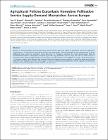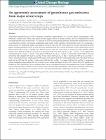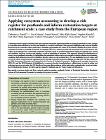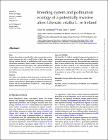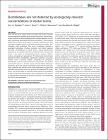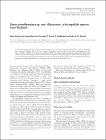Browsing Botany (Scholarly Publications) by Title
Now showing items 1-20 of 179
-
A 1000-year reconstruction of summer precipitation from Ireland: Calibration of a peat-based palaeoclimate record
(2012)Calibration of proxy climate records is well-established for annually resolved proxies such as tree rings, but it has not been attempted for non-annually resolved proxies such as those from peatland surface wetness records. ... -
Agricultural policies exacerbate honeybee pollination service supply-demand mismatches across europe.
(2014)Declines in insect pollinators across Europe have raised concerns about the supply of pollination services to agriculture. Simultaneously, EU agricultural and biofuel policies have encouraged substantial growth in the ... -
An agronomic assessment of greenhouse gas emissions from major cereal crops
(2012)Agricultural greenhouse gas (GHG) emissions contribute approximately 12% to total global anthropogenic GHG emissions. Cereals (rice, wheat, and maize) are the largest source of human calories, and it is estimated that world ... -
Allopolyploidy, diversification, and the Miocene grassland expansion
(2014)The role of polyploidy, particularly allopolyploidy, in plant diversification is a subject of debate. Whole-genome duplications precede the origins of many major clades (e.g., angiosperms, Brassicaceae, Poaceae), suggesting ... -
Anatomical enablers and the evolution of C4 photosynthesis in grasses
(2013)C4 photosynthesis is a series of anatomical and biochemical modifications to the typical C3 pathway that increases the productivity of plants in warm, sunny, and dry conditions. Despite its complexity, it evolved more than ... -
Ant assemblages in successional stages of Scotch Broom stands
(Osterreichische Gesellschaft fur Entomofaunistik, 2006)Scotch Broom (Cytisus scoparius [L.] LINK) stands are important seminatural habitats in cultural landscapes of Ger-many. High structural diversity of broom stands is reflected by a high species diversity of the flora and ... -
Application of the DNDC model to predict emissions of N2O from Irish agriculture.
(2009)A mechanistic model that describes N fluxes from the soil, DeNitrification DeComposition (DNDC), was tested against seasonal and annual data sets of nitrous oxide flux from a spring barley field and a cut and grazed pasture ... -
Applying ecosystem accounting to develop a risk register for peatlands and inform restoration targets at catchment scale: a case study from the European region
(2022)Combining natural capital accounting tools and ecosystem restoration approaches builds on existing frameworks to track changes in ecosystem stocks and flows of services and benefits as a result of restoration. This approach ... -
Applying the System of Environmental Economic Accounting-Ecosystem Accounting (SEEA-EA) framework at catchment scale to develop ecosystem extent and condition accounts
(2021)Ecosystem accounting is a tool to integrate nature into decision-making in a more structured way. Applying the use of nationally available datasets at catchment scale and following the System of Environmental Economic ... -
Arbuscular mycorrhizal fungi in a voltzialean conifer from the Triassic of Antarctica
(2015)Mycorrhizas are intimate mutualistic relationships between plants and fungi that represent an integral component of ancient and extant ecosystems. These symbioses have been established for at least 400 million years and ... -
Archaeosporites rhyniensis gen. et sp. nov. (Glomeromycota, Archaeosporaceae), from the Lower Devonian Rhynie chert a fungal lineage morphologically unchanged from more than 400 million years
(2020)Background and Aims: Structurally preserved arbuscular mycorrhizas from the Lower Devonian Rhynie chert represent core fossil evidence of the evolutionary history of mycorrhizal systems. Moreover, Rhynie chert fossils of ... -
Are field boundary hedgerows the earliest example of a nature-based solution?
(2021)The arrival of the phrase nature-based solutions into the lexicon of academics, planners, managers and policy makers in recent years has sparked a heated debate as to the effectiveness of using nature as a viable solution ... -
Assessing fixed depth carbon stocks in soils with varying horizon depths and thicknesses, sampled by horizon
(2017)Soil surveys for improving carbon (C) stock estimates frequently involve soil sampling by pre-determined regular depth-intervals, in order to enable more convenient computation of soil organic carbon (SOC) stocks. As a ... -
An association between past levels of ozone column depletion and the pollen morphology of the model angiosperm Arabidopsis thaliana L
(2013)The currently reduced stratospheric ozone layer remains sensitive to destructive anthropogenic and natural inputs. We hypothesised that a sudden increase in surface ultraviolet-B (UV-B) irradiation, as may have occurred ... -
Breeding system and pollination ecology of a potentially invasive alien Clematis vitalba L. in Ireland
(2018)Aims Invasive alien plants can greatly affect native communities and ecosystem processes but only a small fraction of alien plant species become invasive. Barriers to establishment and invasion include reproductive ... -
Building capacity for mainstreaming nature-based solutions into environmental policy and landscape planning
(2020)Nature-based solutions (NBS) is a term often used to refer to adequate green infrastructure that provides multiple benefits to society whilst addressing societal challenges. They are defined as actions to protect, sustainably ... -
Bumblebees are not deterred by ecologically relevant concentrations of nectar toxins.
(2014)Bees visit flowers to collect nectar and pollen that contain nutrients and simultaneously facilitate plant sexual reproduction. Paradoxically, nectar produced to attract pollinators often contains deterrent or toxic plant ... -
Buxus sirindhorniana sp. nov. (Buxaceae), a bicarpellate species from Thailand
(2014)A new bicarpellate Buxus species, Buxus sirindhorniana W. K. Soh, M. von Sternburg, Hodk. & J. Parn., is described from northern Thailand. This is the first reported bicarpellate species of Buxus. The pollen morphology and ... -
Capacity-building and networking events for nature-based solutions and re-naturing in Malta
(2020)Nature-based solutions (NbS) have the potential to build climate resilience and tackle key societal challenges while also providing multiple co-benefits to biodiversity and human well-being. The demand for nature-based ...





